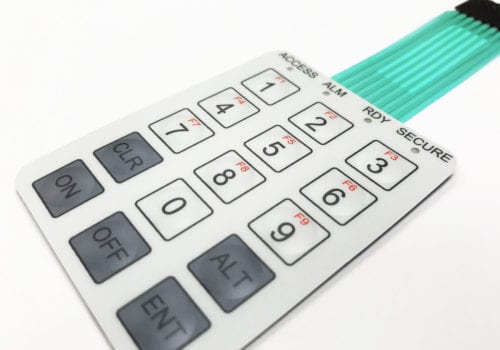The Role of Membrane Switches on the Development of Wearable Devices
The Role of Membrane Switches on the Development of Wearable Devices
Blog Article
Why Membrane Changes Are Necessary for Sturdy Control Systems
Membrane switches play a crucial role in guaranteeing the sturdiness and integrity of control systems across different industries. Their distinct building enables them to withstand difficult environmental aspects such as moisture, temperature extremes, and physical wear. This durability not only extends the lifespan of the systems they serve but also minimizes upkeep requirements. As we explore the diverse benefits of membrane layer switches, it becomes noticeable that their value goes beyond plain functionality, influencing user experience and functional effectiveness. What more effects do these characteristics hold for the future of control system design?
Introduction of Membrane Buttons
Membrane buttons are flexible and dependable elements commonly made use of in numerous electronic control systems. These switches contain several layers, consisting of a visuals overlay, a spacer layer, and a published circuit layer. The graphic overlay provides both functional and visual style, while the spacer layer guarantees that the switches are turned on only when pushed. The published circuit layer includes conductive traces that complete an electric circuit when the membrane is pushed, allowing the tool to reply to user inputs.
Membrane layer buttons are commonly favored in applications needing a compact and light-weight style, making them excellent for handheld devices, medical devices, and commercial equipment. They can be customized to satisfy details individual needs and can integrate different functions such as backlighting, responsive feedback, and several colors. Moreover, membrane layer buttons are immune to dirt, dampness, and pollutants, making them ideal for settings where resilience is crucial.
Benefits of Durability
In several applications, the resilience of membrane layer switches over deals significant advantages that enhance their overall efficiency and integrity. These switches are made to hold up against rough atmospheres, making them perfect for use sought after conditions such as high humidity, severe temperature levels, and direct exposure to chemicals. Their robust construction aids to stop damages from physical impact, guaranteeing durable functionality and reducing the need for frequent substitutes.
Furthermore, membrane switches are immune to damage, which is critical in applications where constant communication takes place. This toughness translates to decrease upkeep expenses, as organizations benefit from decreased downtime and fewer service disturbances. The encapsulated layout of membrane layer changes safeguards internal parts from dirt and wetness ingress, more contributing to their life-span (membrane switch).
One more advantage is their capability to maintain constant efficiency gradually. With a high tolerance for mechanical stress, these buttons protect their tactile responses and electrical stability, making certain individual complete satisfaction. Inevitably, the sturdiness of membrane layer changes not only boosts operational performance but likewise cultivates confidence in their integrity, making them a preferred option for control systems throughout various markets.
Applications in Different Industries
Durable control systems using membrane switches locate extensive applications across a series of industries, each profiting from the one-of-a-kind qualities these buttons provide. In the medical industry, membrane layer switches are essential for devices such as individual displays and analysis equipment, where reliability and simplicity of cleaning are paramount. Their resistance to moisture and pollutants ensures they preserve capability in clean and sterile environments.
The automobile market leverages membrane layer buttons for dashboard controls and infomercial systems, where they give streamlined, low-profile interfaces that enhance customer experience. These buttons are also developed to endure helpful site extreme problems, consisting of direct exposure to extreme temperatures and resonances.
In commercial settings, membrane buttons are generally made use of in equipment control board, supplying responsive responses and longevity required for high-usage applications. Their capability to resist chemicals makes them ideal for making environments where spills and pollutants are frequent.

Consumer electronics, such as kitchen appliances and remote controls, also utilize membrane switches for their adaptability and cost-effectiveness. Overall, the flexibility and durable nature of membrane layer switches over make them crucial throughout different sectors, making certain effective operation and longevity in control systems.
Style and Aesthetic Allure
While performance is paramount, the layout and visual appeal of control systems outfitted with membrane buttons play a vital function in user interaction and overall experience (membrane switch). The aesthetic style of these buttons can considerably affect customer perception and communication. A well-designed membrane layer button enhances the appearance of the device, making it extra attractive to users and cultivating a connection between the individual and the item
Membrane switches use an excellent deal of versatility in design, enabling suppliers to personalize graphics, colors, and appearances to align with brand identification and product aesthetic appeals. The usage of vibrant colors and distinct patterns can draw interest, while responsive feedback can strengthen the individual's interaction with the gadget. In addition, the ability to integrate LED indicators and backlighting into the membrane switch design provides both practical and visual advantages, enhancing visibility and usability in different settings.

Enhancing Individual Experience

Moreover, membrane layer switches can be customized to include visual interfaces, improving use by offering details in a clear and instinctive fashion (membrane switch). This modification can consist of symbols, like it tags, and color coding that guide users through complex functionalities with ease. Additionally, their versatility allows for integration in numerous environments, guaranteeing consistent performance whether in commercial machinery or customer electronic devices
The longevity of membrane layer buttons likewise plays a vital role in user experience. By holding up against rough problems and extended use, these buttons minimize the possibility of system failures, hence advertising reliability and customer self-confidence. Eventually, the tactical usage of membrane layer switches not only elevates performance but likewise considerably enriches customer interaction with control systems, making them an indispensable component in modern-day style.
Verdict

Report this page